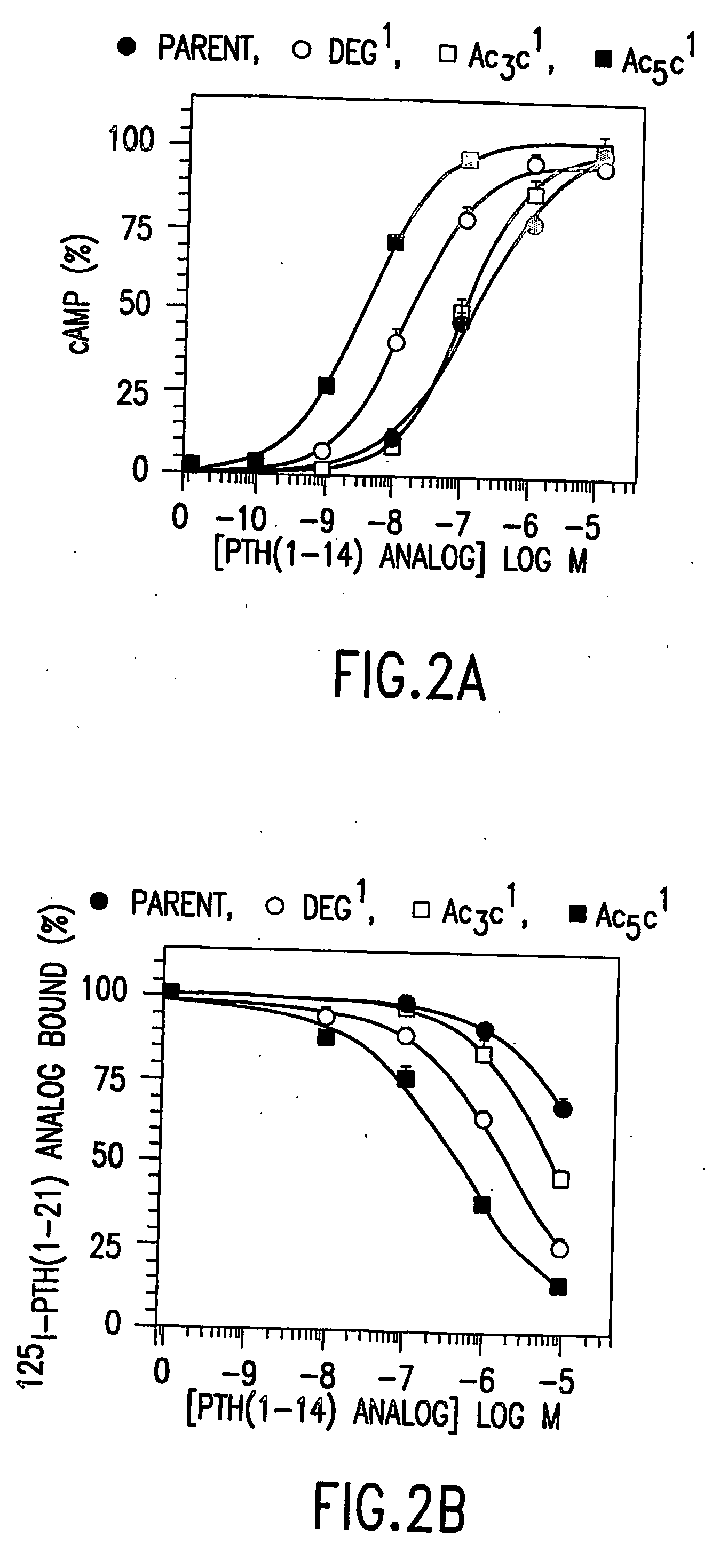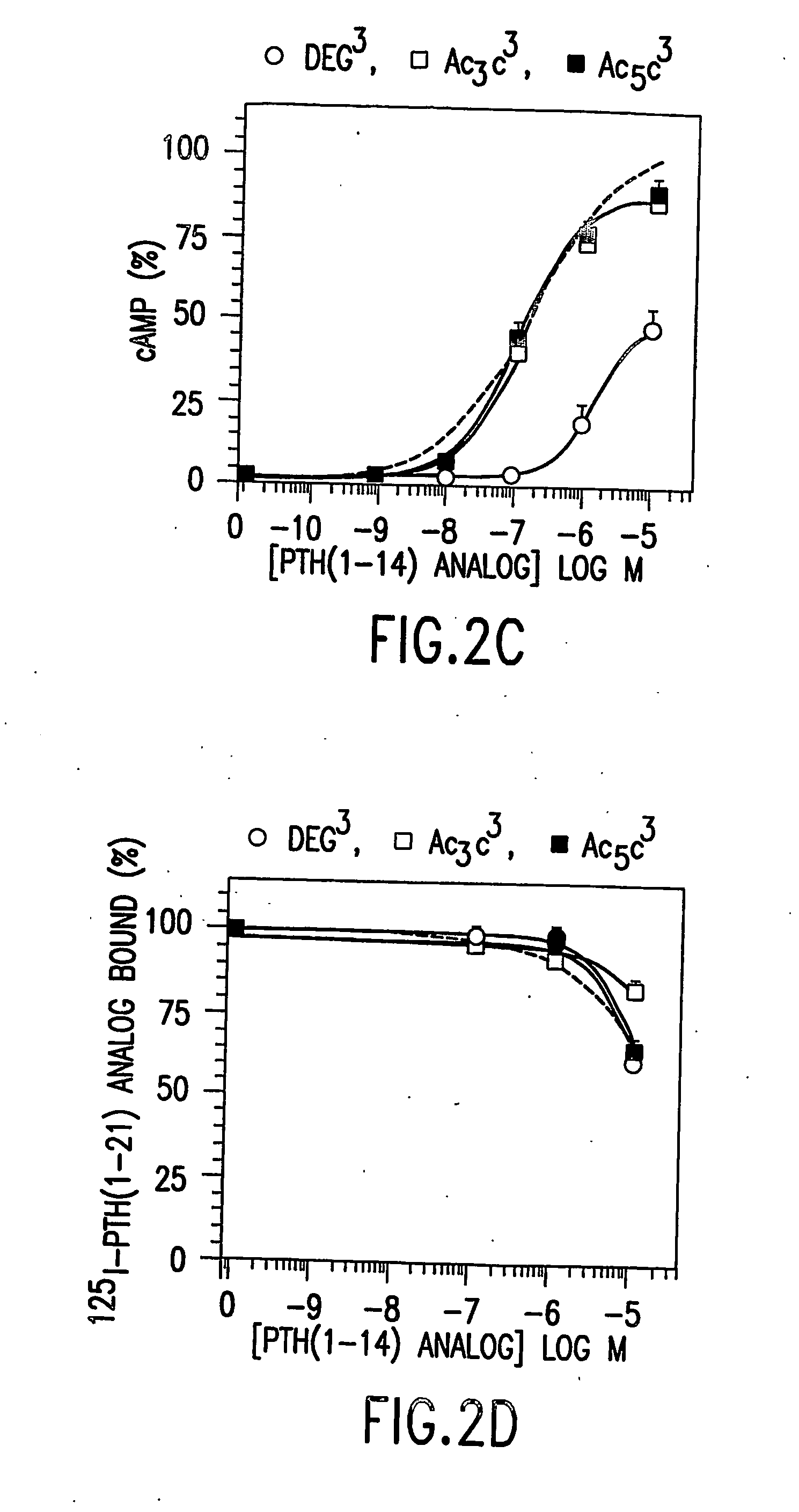Conformationally constrained parathyroid hormones with alpha-helix stabilizers
- Summary
- Abstract
- Description
- Claims
- Application Information
AI Technical Summary
Benefits of technology
Problems solved by technology
Method used
Image
Examples
example 1
Materials and Methods
[0086] Peptides. The amino acid sequences of the peptides used in the study were all derived from human or rat PTH sequences and contain a free amino-terminus and an amidated C-terminus. The parent peptide used as a starting scaffold was [M]PTH(1-14), which is defined as [Ala1,3,12,Gln10,Har11, Trp14]PTH(1-14)NH2 (SEQ. ID. NO. 13). Peptides were prepared on automated peptide synthesizers (model 430A PE, Applied Biosystems, Foster City, Calif., or Model 396 MBS Advanced Chem Tect, Louisville, Ky.) using FMOC main-chain protecting group chemistry, HBTU / HOBt / DIEA (1:1:2 molar ratio) for coupling reactions, and TFA-mediated cleavage / sidechain-deprotection (MGH Biopolymer Synthesis Facility, Boston, Mass.). All peptides were desalted by adsorption on a C18-containing cartridge, and purified further by HPLC. The dry peptide powders were reconstituted in 10 mM acetic acid and stored at −80° C. The purity, identity, and stock concentration for each peptide was secured ...
example 2
P1R Binding Affinity of Analogs Containing α,α-Disubstituted Amino Acids
[0095] The effects of introducing α,α-disubstituted amino acids distinct from Aib at positions 1 and / or3 of[M]PTH(1-14)(M=Ala1,3,12, Gln10, Har11,Trp14) (SEQ. ID. NO. 13) were analyzed. Six amino acids were chosen: α-Amino-isobutyric acid (Aib), α,α-diethylglycine (Deg); 1-arminocyclopropane-1-carboxylic acid (Ac3c); 1-amino-cyclobutane-carboxylic acid (Ac4c), 1-aminocyclopentane-1-carboxylic acid (Ac5c), and 1-amino-cyclohexane-carboxylic acid (Ac6c) (some of which are shown in FIG. 1).
[0096] In competition binding assays performed in an LLC-PK1-derived cell line (B28) that stably expresses the hPTH receptor using 125I-[Aib1,3,Nle8,Gln10,Har11,Ala12,Trp14, Arg19,Tyr21]rPTH(1-21) (SEQ. ID. NO. 36) tracer, the affinities of the Deg3- and Ac5c3-containing analog were comparable to that of [M]PTH(1-14)(IC50s˜3 μM). The affinity of Ac3c3-containing analog was 14-fold lower than that of [M]PTH(1-14), and the affin...
example 3
[0098] The peptide [Ac5C1, Aib3, M]PTH(1-14)(SEQ. ID. NO. 15) was 2-fold more potent than [Aib1,3, M]PTH(1-14) (SEQ. ID. NO. 3) for inhibiting 125I-[Aib1,3,Nle8,Gln10,Har11,Ala12,Trp14, Arg19,Tyr21]rPTH(1-21) (SEQ. ID. NO. 36) binding to B28 cells, and for stimulating adenylyl cyclase, as well as for stimulating phospholipase C (FIG. 2). This peptide is thus one of the most potent PTH(1-14) analog identified so far. Combining Deg1 and Deg3 yielded a peptide that bound with adequate affinity (FIG. 1A) but was a true partial agonist for cAMP formation (FIG. 1B).
[0099] The peptide [Ac5c1, Aib3, Gln10]PTH(1-10) (SEQ. ID. NO. 22) was a fall cAMP agonist, albeit with micromolar potency at 10−4M, [Ac5c1, Aib3]PTH (1-9) (SEQ. ID. NO. 31) exhibited clear agonist activity making it the shortest PTH analog peptide with reliable cAMP agonist activity.
PUM
| Property | Measurement | Unit |
|---|---|---|
| Fraction | aaaaa | aaaaa |
| Frequency | aaaaa | aaaaa |
| Frequency | aaaaa | aaaaa |
Abstract
Description
Claims
Application Information
 Login to View More
Login to View More - R&D
- Intellectual Property
- Life Sciences
- Materials
- Tech Scout
- Unparalleled Data Quality
- Higher Quality Content
- 60% Fewer Hallucinations
Browse by: Latest US Patents, China's latest patents, Technical Efficacy Thesaurus, Application Domain, Technology Topic, Popular Technical Reports.
© 2025 PatSnap. All rights reserved.Legal|Privacy policy|Modern Slavery Act Transparency Statement|Sitemap|About US| Contact US: help@patsnap.com



